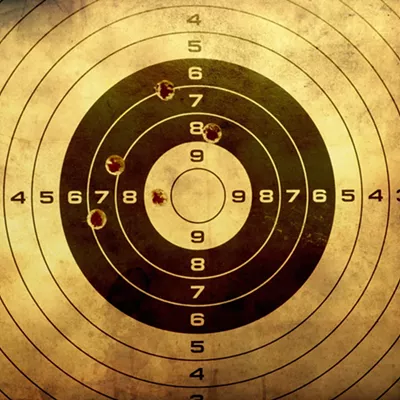The more we learn, the less we know. That could be the underlying message of the ongoing saga of Kennewick Man. As enigmas like K-Man pop up from time to time -- in his case inside Kennewick's city limits during the unlimited hydroplane races in July, 1996 -- we are reminded of how little we really know about the ancient history of our place on this planet. Our technological advances do serve to clarify the question in some ways, but in others they only deepen the mystery -- and the controversy, as is the case with K-Man, who is now the subject of a bitter legal proceeding that will determine his fate. Will he be reburied as an ancient ancestor of five Native American tribes, or will he be preserved by scientists for future study?
Hoping to shine a light on all those issues is James Chatters, the Richland anthropologist who was the first to study the bones and who sparked the controversy by his early pronouncement that the skeleton was "caucasoid." Chatters has written Ancient Encounters (Simon & amp; Schuster, 270 pp.) as his contribution to the ongoing dispute. Part review of the political whirlwind surrounding the find and part speculation on who K-Man really was, it's a must-read for anyone interested in the earliest Americans.
"This story has been mistold so often that my intent is just as an observer, step-by-step, to say, 'Here's what went on' to set the record straight," says Chatters from the Portland stop on his book tour. "This is becoming a part of history, but what's been put out there has been misleading."
Chatters, who has 30-plus years experience in academia and the private sector, has a personal interest in setting the record straight, since in many competing accounts he is cast as the villain of the story. Critics have charged that his statement that the remains were not Native American was pure calculation and part of a grand scheme to challenge NAGPRA (The Native American Graves Protection and Repatriation Act) in court. Many scientists oppose the way the law is currently being applied. In fact, the latest hearing in that legal challenge was held this week in Portland, and Chatters attended, even though he is not a plaintiff in the action.
A handful of scientists are seeking to prove that Kennewick Man is too old to be affiliated with any modern tribe and therefore is not subject to NAGPRA. Whatever decision is handed down is expected to be appealed to the Ninth Circuit Court of Appeals, and many expect the matter to finally be settled by the Supreme Court.
"Congress needed to clarify this law," says Chatters. "NAGPRA is a good idea -- people shouldn't go out and intentionally pillage graves. All those ancient skeletons and recent skeletons that can be tied to modern folks really should be returned to them. Relationships to the really ancient ones cannot be tied to anyone, but the law was written so loosely they can claim anything."
Chatters, who will read from his new book at Auntie's on Thursday, June 28, also argues that he has been unfairly painted as a racist for claiming the skull resembled a European more than a Native American. That initial analysis was contradicted when it turned out the Kennewick Man was 9,500 years old. How could a European be here 450 generations ago, many wondered? Chatters, whose wife is part Native American, now says the remains don't resemble any living humans very closely, although they do come closest to Polynesians and Ainu, the aboriginal people of Japan.
"This is not about race," says Chatters. "It's easy to win an argument if you pull the race card, but it's not really a very fair way to play."
While five tribes claim Kennewick Man as their ancestor and seek to rebury him, Chatters' book seeks to prove that there is no affiliation, and he makes a convincing argument, backed by the latest science and a healthy dose of anthropological speculation. "This definition of Native American denies the possibility that there were other peoples on this continent."
In the end, he argues that to rebury finds like Kennewick Man would be to deny all Americans -- and all humans -- a glimpse into their shared history.
"Instead, we should hold such individuals as national treasures," writes Chatters, "messengers from a long distant past who can educate and enlighten future generations that through scientific advances may be better able to hear the stories these ultimate American elders have to tell."
While the political story may be of greater interest to some readers, what most people will likely pick up the book for is its review of what we know about the settlement of the Americas -- and how Kennewick Man fits into that story. A lot has changed in the way scientists think it occurred, even since K-Man was unearthed.
The prevailing belief since the 1920s had been that a small band of north Asians traveled across a land bridge between Siberia and Alaska about 13,000 years ago, when cold temperatures lowered the sea level and created a land bridge there -- a place called Beringia. That band spread out, the theory goes, and populated both North and South America within a few hundred years. That theory, however, has started to show cracks in its foundation.
"Could it be that the peopling of the Americas had been a more complex process than we once had thought?" writes Chatters.
How does that theory explain finds in the far reaches of South America that roughly correspond to or even predate the supposed land bridge migration? Also, estimated fertility rates don't seem to support the idea of one band populating two continents in so short a time. Chatters supports the growing sentiment among some scientists that the settlement may have occurred in waves, and much of it could have taken place by boat along the coastline.
"It is easy to envision an Asian maritime culture expanding north into Kamchatka and out onto the Beringian coast, occupying the area for a few centuries, and exploring its way to America," writes Chatters. "When this first group was exterminated or forced to abandon the northernmost coast by the cooling climate, the peoples of Asia and America would have become separated, both culturally and biologically, until Beringia again became habitable and the process could be repeated."
Chatters says scientists have shown that coastally adapted people could have made it from the eastern Aleutian Islands to the Columbia River in a year; they could have made it to Chile in less than five years. Some of the skepticism has come from the idea that people were not technologically advanced enough to cross water at such distances, but other historical evidence contradicts that claim. Japan was settled by boat some 34,000 years ago, and Australia was similarly settled around 40,000 years ago, not long after Homo sapiens first emerged.
The Pacific Rim model of settlement Chatters believes in also explains Kennewick Man, who, according to the preponderance of available evidence, does not resemble any living human group. To bolster his case, Chatters even takes the reader on another investigation, an even trickier one than K-Man presented. At Central Washington University, a skull was in the collection that had no paperwork with it. No one knew where it came from, but it resembled Kennewick Man. In fact, further study showed it to be from the same era and to be a likely relative. Employing such technologies as pollen sampling and mitochondrial DNA, Chatters and his colleagues even nailed down its likely place of origin to within a few hundred miles of Kennewick Man's final resting place.
Stick Man, as they named him, proves that there were more of this group, but their kind did not survive into the modern era. "We tend to think in terms of a history that is made up of a human tree of very few branches," says Chatters, "In point of fact, it is more of a history of a bush, and most of the branches are dead."
Chatters concludes that K-Man may have been descended from the same seafaring people who settled Japan. Perhaps a band of them lived and spread throughout what is now Eastern Washington along the Columbia River. The people later died out either by disease or at the hands of more technologically advanced newcomers, who may have come over the land bridge and who may have been the ancestors of modern Native Americans.
But it's still an unsolved mystery, and it's one of the more captivating ones left to us as we understand more and more about the world around us. And, says Chatters, it's a mystery we all share in common, regardless of race.
"We don't really belong anywhere else," says Chatters of the recent immigrants like himself who live on the same land that Kennewick Man once did. "This is our home, and this land is as important to us as it is to anyone else. The history of this land helps enrich our sense of belonging and our understanding of ourselves as human."
James Chatters will read from
Ancient Encounters at Auntie's Bookstore on Thursday, June 28, at
7:30 pm. Call: 838-0206. He'll sign books
at Hastings in Coeur d'Alene on Friday,
June 29, at 6 pm. Call: (208) 664-0464.




















